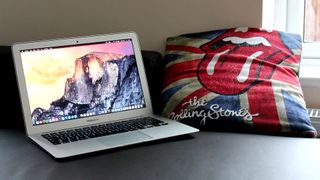The arrival of Apple's 12-inch MacBook earlier last year marked the beginning of the end for its MacBook Air lineup. At least, that's what people said at the time.
The new MacBook is more portable, lighter, has a gorgeous high-resolution display and can go for almost as long as the Air on a single charge. Who would pick a machine stuck in the past over a laptop from the future?

As it turns out, the future's not all it's cracked up to be. The new MacBook's inconvenient USB Type-C port, controversial keyboard and moderately powerful Intel Core M chip have proved a compromise too many for some people.
Now that Apple has refreshed its 11- and 13-inch MacBook Air models with Intel's fifth-generation Broadwell processors, Intel HD Graphics 6000 and Thunderbolt 2, they're suddenly looking much more appealing, even if it's business as usual on the outside.
Recent developments
Though rumors suggest the MacBook Air could be eliminated altogether, we're not convinced. The MacBook Air 2016 has been all but confirmed at this point, alongside a more glamorous set of MacBook Pro 2016 models.
The latest MacBook Air, which is nearly a year and a half old at this point, is suggested to ship in two sizes: 13 and 15 inches, replacing the 11-inch MacBook Air of the past. Both, we believe, will come fully stocked with the latest Skylake processors, to be succeeded shortly thereafter only by the marginally more powerful Kaby Lake microarchitecture.
The new MacBook Air 2016 models will reportedly utilize USB-C ports in the spirit of the 12-inch MacBook, effectively making an even slimmer chassis easier to digest. If you don't plan on making the upgrade, however, your current MacBook Air won't be outdated. Quite the contrary actually.
Thanks to the advent of macOS Sierra, you can expect new features like Siri, Apple Pay and the TouchID-esque Auto Unlock to make their way to your current MacBook Air later this year, assuming it's compatible.
Design
Speaking of which, the MacBook Air's design has now remained unchanged for five long years. If Apple didn't feel the need to tinker with it before, there's even less chance that it'll change any time soon now that the 12-inch MacBook is out there. Which is a shame, because the Air's classic design could really benefit from slimmer bezels and an overall reduction in footprint.
Forget the Dell XPS 13's physics-defying Infinity Display, which is lightyears ahead – even Apple's 13-inch MacBook Pro with Retina, once seen as slightly tubby compared to the Air, has a smaller footprint and takes up slightly less space on your lap.

Still, the old "if it ain't broke" mantra applies – up to a point. The MacBook Air's aluminium unibody design, which supports the main enclosure and the display, is as durable as ever. Its lid can be easily raised with a single hand and doesn't droop in any position, and you have to press really hard to detect flex on the machine's base or lid.
It's also easy to clean with a damp cloth. If there's one drawback, it's that the aluminium body can scratch easily to leave permanent black marks, so you should consider buying a sleeve if you're going to sling it into a bag for transportation.
Aucun commentaire:
Enregistrer un commentaire